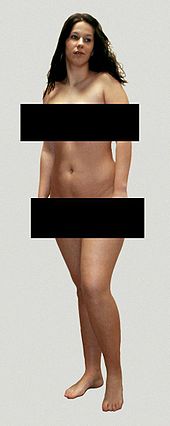Censor bar
The censor bar ( porn bar) was originally a mostly black bar that was used to cover the primary and particularly conspicuous secondary sexual characteristics in images of unclothed or only partially clad people, mostly women . This was done in order not to violate public morality and to avoid possible legal or regulatory consequences due to arousing public nuisance and / or endangering young people, etc. Especially for anonymity as a bar over the eyes of used eye beams .
history
In particular, such black bars were common in corresponding images on film posters and in the notices of cinemas , as well as in print media of all kinds, especially on front pages . The showcases of vaudeville shows , bars , nightclubs and striptease places also liked to cover the breasts and the pubic area of their exhibited dancers with stars made of gold or silver foil, with red hearts or with the black bars. Over time, however, the censorship bars also became an eye-catcher and a hint that should arouse interest and express: "Please, everyone, there is something to see here that is actually not allowed to be shown in public!"
Since after the sexual revolution of the 1960s a bare breast or even a completely naked person is hardly understood as a public nuisance, the censorship bar has almost completely disappeared from the showcases etc. and the print media.
Legal background in Germany
Since the German Basic Law with the art. 5 , a state (pre) censorship explicitly forbids, at the initiative of the state through 1949, the Voluntary Self-Regulation of the Film Industry founded (FSK), 1956, the federal inspection station for youth-endangering writings (BPjS). The measures ordered by these bodies - in particular coverings with bars or the like, shortening, making inaudible through whistling sounds, as well as cuts etc. - have so far been rather rare in relation to the respective total number of published works in books, comics and records, in films and videos however, it is used more frequently.
See also
literature
- Roland Seim, Josef Spiegel (ed.): “From 18” - censored, discussed, suppressed. Examples from the cultural history of the Federal Republic of Germany. Vol. 1: "The third degree" . 7th reprint of 3rd, verb., Revised. and updated edition - original reprint of the catalog from 1995/1998, Telos-Verlag, Münster / Westf. 2004, ISBN 3-933060-01-X .
- Roland Seim, Josef Spiegel (ed.): The commented illustrated book on “From 18” - censored, discussed, suppressed. Censorship in German cultural history . Reprint of the 2nd, verb. and exp. Ed., Telos-Verlag, Münster / Westf. 2004 (= "From 18" - censored, discussed, suppressed; Vol. 2), ISBN 3-933060-05-2 .

